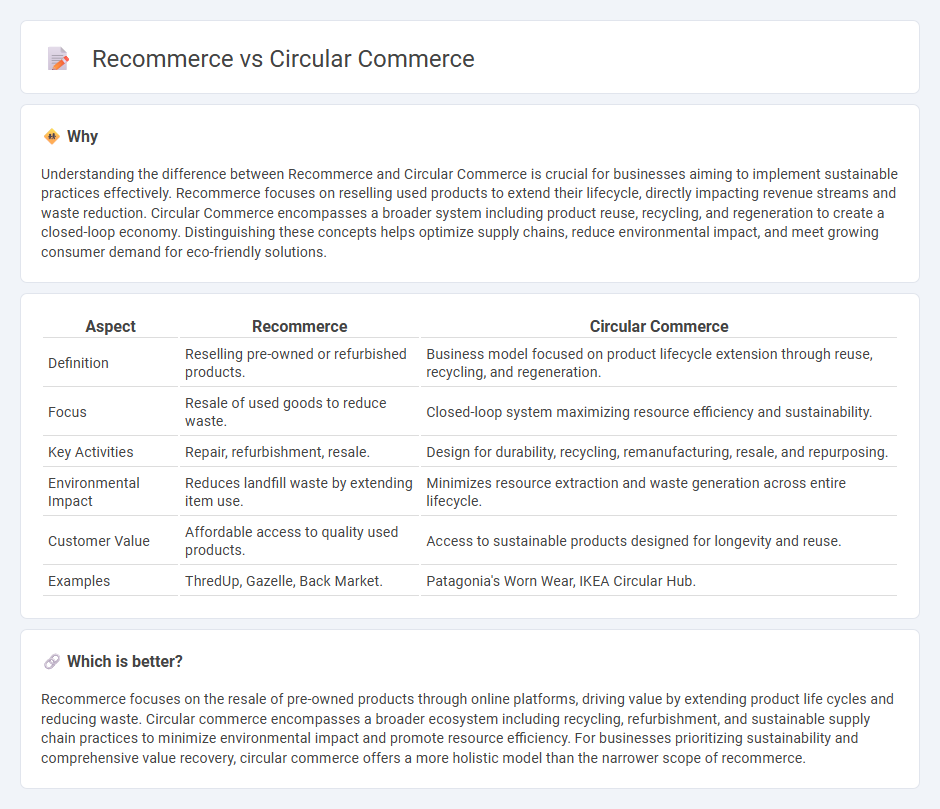
Recommerce focuses on reselling pre-owned products through platforms that facilitate trade-in, refurbishment, and resale, driving sustainable consumption by extending product lifecycle. Circular commerce emphasizes a closed-loop system where resources are continually reused, recycled, or regenerated to minimize waste and environmental impact in supply chains. Explore deeper insights into how recommerce and circular commerce reshape sustainable business models.
Why it is important
Understanding the difference between Recommerce and Circular Commerce is crucial for businesses aiming to implement sustainable practices effectively. Recommerce focuses on reselling used products to extend their lifecycle, directly impacting revenue streams and waste reduction. Circular Commerce encompasses a broader system including product reuse, recycling, and regeneration to create a closed-loop economy. Distinguishing these concepts helps optimize supply chains, reduce environmental impact, and meet growing consumer demand for eco-friendly solutions.
Comparison Table
| Aspect | Recommerce | Circular Commerce |
|---|---|---|
| Definition | Reselling pre-owned or refurbished products. | Business model focused on product lifecycle extension through reuse, recycling, and regeneration. |
| Focus | Resale of used goods to reduce waste. | Closed-loop system maximizing resource efficiency and sustainability. |
| Key Activities | Repair, refurbishment, resale. | Design for durability, recycling, remanufacturing, resale, and repurposing. |
| Environmental Impact | Reduces landfill waste by extending item use. | Minimizes resource extraction and waste generation across entire lifecycle. |
| Customer Value | Affordable access to quality used products. | Access to sustainable products designed for longevity and reuse. |
| Examples | ThredUp, Gazelle, Back Market. | Patagonia's Worn Wear, IKEA Circular Hub. |
Which is better?
Recommerce focuses on the resale of pre-owned products through online platforms, driving value by extending product life cycles and reducing waste. Circular commerce encompasses a broader ecosystem including recycling, refurbishment, and sustainable supply chain practices to minimize environmental impact and promote resource efficiency. For businesses prioritizing sustainability and comprehensive value recovery, circular commerce offers a more holistic model than the narrower scope of recommerce.
Connection
Recommerce and circular commerce both emphasize sustainability by prioritizing the reuse and resale of products to reduce waste and extend product life cycles. Recommerce involves buying and selling pre-owned goods, directly supporting circular commerce's goal of minimizing resource consumption through closed-loop systems. Together, they drive eco-friendly shopping behaviors and contribute to a regenerative economy focused on maximizing material value and reducing environmental impact.
Key Terms
Product Lifecycle
Circular commerce emphasizes the complete product lifecycle by designing, using, and reintegrating products to minimize waste and maximize resource efficiency. Recommerce focuses specifically on the resale and refurbishment of used goods to extend product life and reduce environmental impact. Explore the differences in how these models transform sustainability in retail and consumption.
Resale Platform
Circular commerce integrates product lifecycle management with resale platforms to maximize resource efficiency and minimize waste, promoting sustainability in consumer behavior. Recommerce specifically refers to the business model focused on the resale of pre-owned goods through digital marketplaces, enhancing product value and extending usability. Discover how resale platforms are transforming retail ecosystems and driving circular economy growth.
Resource Optimization
Circular commerce emphasizes the entire product lifecycle by maximizing resource efficiency through reuse, recycling, and sustainable design to reduce waste and environmental impact. Recommerce specifically targets the resale and refurbishment of used goods, extending product value and minimizing raw material extraction. Explore how integrating circular commerce and recommerce strategies can revolutionize resource optimization for businesses.
Source and External Links
Circular Commerce: The Life of Manufactured Products - Circular commerce is a regenerative and sustainable system that extends product lifecycles, eliminates waste and pollution, and integrates renewable energy in supply chains, promoting economic resilience and environmental sustainability.
Circular commerce: enhancing customer loyalty through ... - Circular commerce applies circular economy principles to business by emphasizing product durability, repair, resale, and recycling, which builds customer trust and loyalty while reducing environmental impact.
What is Circular Economy & How Does It Work? - Circular commerce is part of the circular economy, an industrial system designed to continuously reuse and regenerate materials through repair, remanufacturing, and recycling to reduce waste and resource consumption.
 dowidth.com
dowidth.com